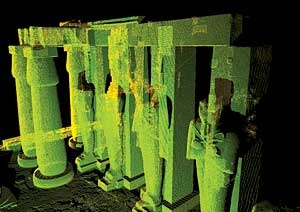Open-access digital archive of international archaeological sites set to launch
September 14, 2006
Conservators, architects, academics, and armchair archaeologists will soon be able to access detailed digital documentation of some of the world’s most famous cultural sites via the Web.
At press time, the nonprofit Kacyra Family Foundation (KFF) was slated to launch its CyArk 3D Heritage Archive in mid-August.
The open-access www.cyark.org will initially include documentation of nine sites as diverse as the South Dakota gold rush town Deadwood; the ancient Khmer capital Angkor, in Cambodia; and Pompeii, in southern Italy. Foundation officials hope the archived material will be used for site management, restoration, and education.
The monuments, many of which have been designated World Heritage sites by the United Nations Educational Scientific and Cultural Organization, have been documented with a variety of techniques. The core technology is 3D laser scanning, which uses a tripod-mounted laser device to scan objects and produces a digital collection, or “cloud,” of points in three dimensions. This data can be reassembled to create other media, including detailed 3D models, dimensioned 2D drawings, and animations.
The foundation assists site authorities and academic institutions with planning and financing; helps locate professional surveyors with scanning equipment, who often donate their services; and provides software and training, says Ben Kacyra, KFF director and founder of Cyra Technologies, which was acquired by Leica Geosystems in 2001. (Cyra’s 3D scanning technology is used to document many of the archived sites.) “Finally,” he says, “we are a repository for the information.”
Although only a handful of sites will initially be featured, KFF plans to expand CyArk quickly, not necessarily limiting it to projects documented through the foundation’s involvement or to those using Cyra’s technology, says Kacyra. “Our ambition is to help in 3D scanning, high-definition documentation, and archiving of the top 100 to 150 endangered heritage sites worldwide in the next five years.”
At press time, the nonprofit Kacyra Family Foundation (KFF) was slated to launch its CyArk 3D Heritage Archive in mid-August.
The open-access www.cyark.org will initially include documentation of nine sites as diverse as the South Dakota gold rush town Deadwood; the ancient Khmer capital Angkor, in Cambodia; and Pompeii, in southern Italy. Foundation officials hope the archived material will be used for site management, restoration, and education.
The monuments, many of which have been designated World Heritage sites by the United Nations Educational Scientific and Cultural Organization, have been documented with a variety of techniques. The core technology is 3D laser scanning, which uses a tripod-mounted laser device to scan objects and produces a digital collection, or “cloud,” of points in three dimensions. This data can be reassembled to create other media, including detailed 3D models, dimensioned 2D drawings, and animations.
The foundation assists site authorities and academic institutions with planning and financing; helps locate professional surveyors with scanning equipment, who often donate their services; and provides software and training, says Ben Kacyra, KFF director and founder of Cyra Technologies, which was acquired by Leica Geosystems in 2001. (Cyra’s 3D scanning technology is used to document many of the archived sites.) “Finally,” he says, “we are a repository for the information.”
Although only a handful of sites will initially be featured, KFF plans to expand CyArk quickly, not necessarily limiting it to projects documented through the foundation’s involvement or to those using Cyra’s technology, says Kacyra. “Our ambition is to help in 3D scanning, high-definition documentation, and archiving of the top 100 to 150 endangered heritage sites worldwide in the next five years.”



These images of the Ramesseum, in Luxor, Egypt, are representative of the material in the CyArk archive.